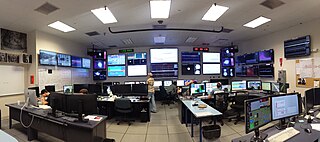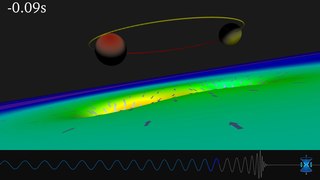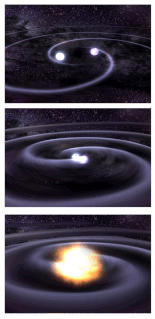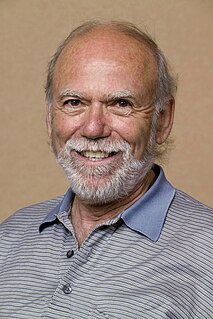Related Research Articles

The Laser Interferometer Gravitational-Wave Observatory (LIGO) is a large-scale physics experiment and observatory to detect cosmic gravitational waves and to develop gravitational-wave observations as an astronomical tool. Two large observatories were built in the United States with the aim of detecting gravitational waves by laser interferometry. These observatories use mirrors spaced four kilometers apart which are capable of detecting a change of less than one ten-thousandth the charge diameter of a proton.

Rainer "Rai" Weiss is an American physicist, known for his contributions in gravitational physics and astrophysics. He is a professor of physics emeritus at MIT and an adjunct professor at LSU. He is best known for inventing the laser interferometric technique which is the basic operation of LIGO. He was Chair of the COBE Science Working Group.

The Max Planck Institute for Gravitational Physics is a Max Planck Institute whose research is aimed at investigating Einstein's theory of relativity and beyond: Mathematics, quantum gravity, astrophysical relativity, and gravitational-wave astronomy. The Institute was founded in 1995 and is located in the Potsdam Science Park in Golm, Potsdam and in Hannover where it is closely related to the Leibniz University Hannover. The Potsdam part of the institute is organized in three research departments, while the Hannover part has two departments. Both parts of the institute host a number of independent research groups.

GEO600 is a gravitational wave detector located near Sarstedt South of Hanover, Germany. It is designed and operated by scientists from the Max Planck Institute for Gravitational Physics, Max Planck Institute of Quantum Optics and the Leibniz Universität Hannover, along with University of Glasgow, University of Birmingham and Cardiff University in the United Kingdom, and is funded by the Max Planck Society and the Science and Technology Facilities Council (STFC). GEO600 is capable of detecting gravitational waves in the frequency range 50 Hz to 1.5 kHz, and is part of a worldwide network of gravitational wave detectors. This instrument, and its sister interferometric detectors, when operational, are some of the most sensitive gravitational wave detectors ever designed. They are designed to detect relative changes in distance of the order of 10−21, about the size of a single atom compared to the distance from the Sun to the Earth. Construction on the project began in 1995.

Ronald William Prest Drever was a Scottish experimental physicist. He was a professor emeritus at the California Institute of Technology, co-founded the LIGO project, and was a co-inventor of the Pound–Drever–Hall technique for laser stabilisation, as well as the Hughes–Drever experiment. This work was instrumental in the first detection of gravitational waves in September 2015.

The gravitational wave background is a random gravitational-wave signal potentially detectable by gravitational wave detection experiments. Since the background is supposed to be statistically random, it has yet been researched only in terms of such statistical descriptors as the mean, the variance, etc.

The Virgo interferometer is a large interferometer designed to detect gravitational waves predicted by the general theory of relativity. Virgo is a Michelson interferometer that is isolated from external disturbances: its mirrors and instrumentation are suspended and its laser beam operates in a vacuum. The instrument's two arms are three kilometres long and located in Santo Stefano a Macerata, near the city of Pisa, Italy.

Gravitational waves are disturbances in the curvature of spacetime, generated by accelerated masses, that propagate as waves outward from their source at the speed of light. They were proposed by Henri Poincaré in 1905 and subsequently predicted in 1916 by Albert Einstein on the basis of his general theory of relativity. Gravitational waves transport energy as gravitational radiation, a form of radiant energy similar to electromagnetic radiation. Newton's law of universal gravitation, part of classical mechanics, does not provide for their existence, since that law is predicated on the assumption that physical interactions propagate instantaneously – showing one of the ways the methods of classical physics are unable to explain phenomena associated with relativity.

A gravitational-wave detector is any device designed to measure tiny distortions of spacetime called gravitational waves. Since the 1960s, various kinds of gravitational-wave detectors have been built and constantly improved. The present-day generation of laser interferometers has reached the necessary sensitivity to detect gravitational waves from astronomical sources, thus forming the primary tool of gravitational-wave astronomy.

Gravitational-wave astronomy is an emerging branch of observational astronomy which aims to use gravitational waves to collect observational data about objects such as neutron stars and black holes, events such as supernovae, and processes including those of the early universe shortly after the Big Bang.
The LIGO Scientific Collaboration (LSC) is a scientific collaboration of international physics institutes and research groups dedicated to the search for gravitational waves.
An interferometric gravitational-wave detector is a gravitational wave detector that uses the wave interference to detect gravitational waves. Laser interferometers detects gravitational waves that extend and contract the distance between mirrors. Atom interferometers are proposed to detect gravitational waves, which would lengthen or shorten the distance between recombining atom clouds. Interferometric gravitational-wave detectors are one class of detectors and for more information about other types of instruments used for gravitational wave detection see the article on gravitational wave observatories.

Alessandra Buonanno is a theoretical physicist. She is a director at the Max Planck Institute for Gravitational Physics in Potsdam, and head of the "Astrophysical and Cosmological Relativity" department. She holds a College Park professorship at the University of Maryland, College Park, and honorary professorships at the Humboldt University in Berlin, and the University of Potsdam. She is a leading member of the LIGO Scientific Collaboration, which observed gravitational waves from a binary black-hole merger in 2015.

Barry Clark Barish is an American experimental physicist and Nobel Laureate. He is a Linde Professor of Physics, emeritus at California Institute of Technology and a leading expert on gravitational waves.

Heinz Billing was a German physicist and computer scientist, widely considered a pioneer in the construction of computer systems and computer data storage, who built a prototype laser interferometric gravitational wave detector.

The first direct observation of gravitational waves was made on 14 September 2015 and was announced by the LIGO and Virgo collaborations on 11 February 2016. Previously, gravitational waves had been inferred only indirectly, via their effect on the timing of pulsars in binary star systems. The waveform, detected by both LIGO observatories, matched the predictions of general relativity for a gravitational wave emanating from the inward spiral and merger of a pair of black holes of around 36 and 29 solar masses and the subsequent "ringdown" of the single resulting black hole. The signal was named GW150914. It was also the first observation of a binary black hole merger, demonstrating both the existence of binary stellar-mass black hole systems and the fact that such mergers could occur within the current age of the universe.
David Ernest McClelland is an Australian physicist, with his research focused on the development of the manipulation and control of optical quantum states, and its implementation into gravitational wave observatories. He is a Fellow of the Australian Academy of Science, the American Physical Society and the Optical Society of America. He has published over 300 journal articles. He was the lead investigator for the Australian hardware contribution to the Advanced LIGO (USA) that, in September 2015, made the first direct observation of gravitational waves. He is a recipient of the Joseph F Keithley Award for Advances in Measurement Science (2013) and the 2017 Walter Boas Medal. Currently he is a Distinguished Professor at The Australian National University in Canberra (Australia). He is Director of the ANU's Centre for Gravitational Astrophysics and Deputy Director of OzGrav - the Australian Research Council Centre of Excellence in Gravitational Wave Discovery.
PyCBC is an open source software package primarily written in the Python programming language which is designed for use in gravitational-wave astronomy and gravitational-wave data analysis. PyCBC contains modules for signal processing, FFT, matched filtering, gravitational waveform generation, among other tasks common in gravitational-wave data analysis.
Michel Davier is a French physicist.
Peter Reed Saulson is an American physicist and professor at Syracuse University. He is best known as a former spokesperson for the LIGO collaboration serving from 2003 to 2007 and research on gravitational wave detectors.
References
- ↑ Henderson, Mark (20 August 2009). "'Non-discovery' of space-time ripples opens door to birth of the Universe". The Times. Retrieved 15 November 2009.CS1 maint: discouraged parameter (link)
- ↑ Svitil, Kathy (24 August 2011). "New LIGO Executive Director Named". California Institute of Technology. Archived from the original on 6 December 2017. Retrieved 5 January 2013.
- ↑ Vieru, Tudor (24 August 2011). "LIGO Experiment Gets New Executive Director". Softpedia.
- ↑ "LIGO-India". IndiGO .
- ↑ Twilley, Nicola. "Gravitational Waves Exist: The Inside Story of How Scientists Finally Found Them". The New Yorker. ISSN 0028-792X . Retrieved 11 February 2016.
- ↑ Abbott, B.P.; et al. (LIGO Scientific Collaboration and Virgo Collaboration) (11 February 2016). "Observation of Gravitational Waves from a Binary Black Hole Merger". Phys. Rev. Lett. 116: 061102. arXiv: 1602.03837 . Bibcode:2016PhRvL.116f1102A. doi:10.1103/PhysRevLett.116.061102. PMID 26918975.
- ↑ Naeye, Robert (11 February 2016). "Gravitational Wave Detection Heralds New Era of Science". Sky and Telescope. Retrieved 11 February 2016.CS1 maint: discouraged parameter (link)
- ↑ Castelvecchi, Davide; Witze, Alexandra (11 February 2016). "Einstein's gravitational waves found at last". Nature News. doi:10.1038/nature.2016.19361 . Retrieved 11 February 2016.CS1 maint: discouraged parameter (link)
- ↑ "NAS online awards".
- ↑ Reitze, David; Saulson, Peter; Grote, Hartmut (2019). Advanced Interferometric Gravitational-Wave Detectors. World Scientific. ISBN 978-981-3146-07-5.